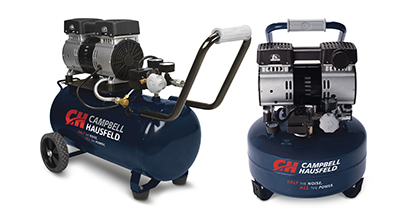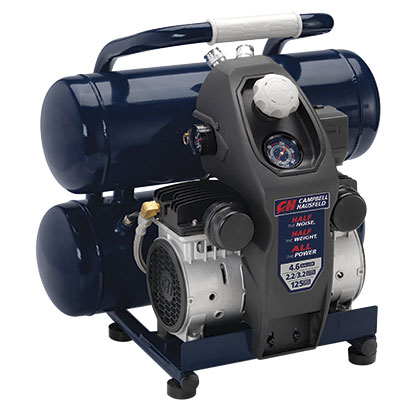Contractors want compressors that offer portability, quiet performance, reliability, and reduced maintenance. It’s important that a compressor provides the performance to power a range of jobs—while also offering quiet operation resulting in a quieter jobsite and improved worker safety and communication. A compressor should provide contractors with peace of mind and not be a source of worry.
This article discusses some key considerations for small-scale contractors when choosing the right compressor and how manufacturers are addressing these issues through improved technology and design.
ISSUE NO. 1: PORTABILITY
Equipment portability is crucial on most jobsites. Not only must the equipment be easy to transport to the worksite, but it’s also common that once on-site, workers must walk through mud or across beams to get equipment where it needs to be.
Because of these reasons, contractors are looking for lightweight equipment. Small-scale contractors typically use a 4- or 5-gallon electric twinstack compressor or a 6-gallon pancake-style compressor. Contractors with larger crews on a jobsite may opt for an 8-gallon gas powered wheelbarrow-style compressor.
To meet the demand for greater portability, some manufacturers are developing compressors made from lighter weight materials. However, keep in mind that portability goes beyond weight and size. Compressor design also plays a role in portability. Look for a unit that offers handholds so it can easily be carried by hand. Manufacturers also offer slim or vertical versions utilizing a streamlined design. In addition, some manufacturers offer compressors that are designed to fit in tight spaces, such as the backseat of a vehicle, so the units can be easily transported to the jobsite.
ISSUE NO. 2: PERFORMANCE
Ensuring that the compressor has enough power and performance to complete a wide variety of jobsite tasks and run jobsite tools is another important consideration for contractors.
A typical compressor product in the consumer retail market would range in performance from .5 to 2 cubic feet per minute (cfm), while small-scale contractors generally require a compressor that provides from 2 to 5 cfm of output. Most compressors of this size used by small-scale contractors run on single-phase, 120-volt power, so they can be used on most jobsites with an extension cord, power outlet, or generator. The right compressor output for the application all depends on what tools will be used on the job and how many people will use the compressor. Larger air compressors are gas powered, as sometimes electricity is not available or the performance requirements of a larger crew are more. In this scenario, a larger compressor may have output of 5 to 15 cfm.
The compressor should be able to produce enough air to keep up with tools required for the job. A compressor with a higher cfm output can produce more air in the same amount of time—so workers can shoot more nails, use bigger tools, and complete jobs quicker.

ISSUE NO. 3: QUIET OPERATION
Another significant issue to consider is the noise level of the compressor. Conventional air compressors typically have a sound output of 87 to 93 dBa—equivalent to a blender or lawn mower. These output levels make it difficult for workers on a jobsite to have a conversation, which can impact productivity and safety while also causing a nuisance for neighbors or other businesses in the area. OSHA recommends using hearing protection to help prevent hearing loss in the cases of prolonged exposure over 85 decibels.
Because conversations can occur at 72 dBa and below, this range is optimal for jobsite safety and efficiency. Campbell Hausfeld offers Quiet Compressors with a sound output of 68 decibels—up to 50 percent less than conventional compressor designs—which is low enough that hearing protection is not required and workers on the jobsite can easily converse with one another.
The reduced noise is the result of technology that runs the motor at a slower speed. Utilizing two pumps instead of one allows the air compressor to still run without sacrificing performance. This results in much quieter operation.
One example that speaks to the advantages of quiet compressor operation comes from Scott Becker, construction site superintendent for Habitat for Humanity of Greater Cincinnati. Becker and his team work around the clock—often at night—building sustainable housing for Cincinnati families in need. Since traditional air compressors were too noisy to operate in the evening, Becker would leave the compressor running in his van to dampen the roar of the motor. This required him to run several hoses and cords from the compressor to the work area, making work inconvenient and difficult. With the Campbell Hausfeld Quiet Compressor, he’s able to power his tools at any time without disturbing neighbors or leaving valuable equipment in his vehicle.
ISSUE NO. 4: PRODUCT LIFE AND MAINTENANCE
Lastly, dependable performance and long product life are additional factors that are important for contractors, so they don’t have to spend time and money—and potentially stop work—to leave the jobsite to buy a new compressor or a part for a fix. Contractors must be able to count on their compressor to help them get the job done with as little maintenance as possible.
Many air compressors on the market use oil-lubed pumps, which means they require adding oil and changing oil on a regular basis—maintenance that costs time and money. Oil-lubed compressors have been a common choice in the past because they typically provide longer product life.
However, technology advancements now allow an oil-free compressor to provide up to 2,000 hours of life, which can be much greater than conventional oil-lubed designs. For example, the 6-gallon Quiet Compressor from Campbell Hausfeld has a motor that runs slower, which helps extend product life, in addition to the oil-free pump design that provides maintenance-free operation.
While an oil-free compressor may require a slightly higher upfront investment, it can pay off by potentially doubling the product life of an oil-lubed compressor. In the case of the Quiet Compressor, it also offers nearly four times the life of a comparable oil-free product.
CHOOSING THE BEST FIT FOR THE JOB
Contractors are busy. They want equipment that helps them keep their projects moving, so they can meet deadlines and complete jobs in a timely manner. Choosing the right equipment can help them meet these goals and make them more competitive—for a positive impact on the bottom line. ■
About the Author: Brandon Cross is an engineering/product manager with Campbell Hausfeld. For more information, visit www.campbellhausfeld.com.
_________________________________________________________________________
Modern Contractor Solutions – January 2017
Did you enjoy this article?
Subscribe to the FREE Digital Edition of Modern Contractor Solutions magazine.

Home Equipment Solutions Choosing the Right Compressor Can Help Maximize Uptime and Reduce Jobsite Noise
Choosing the Right Compressor Can Help Maximize Uptime and Reduce Jobsite Noise


